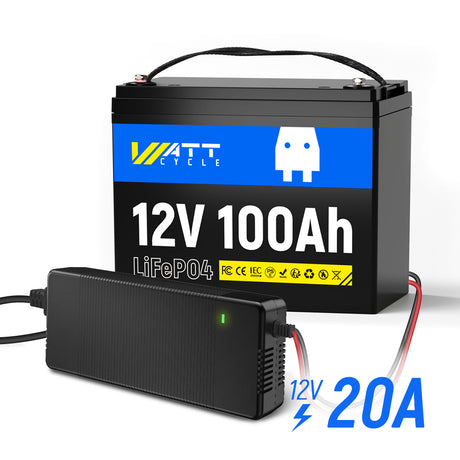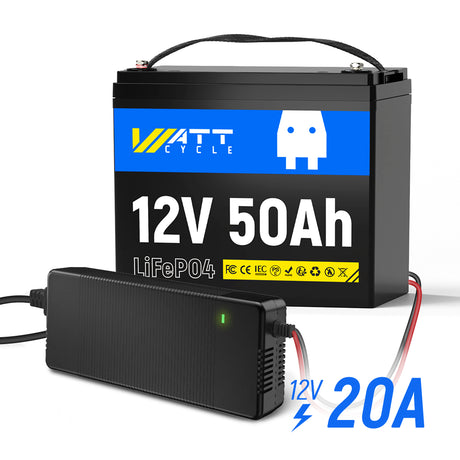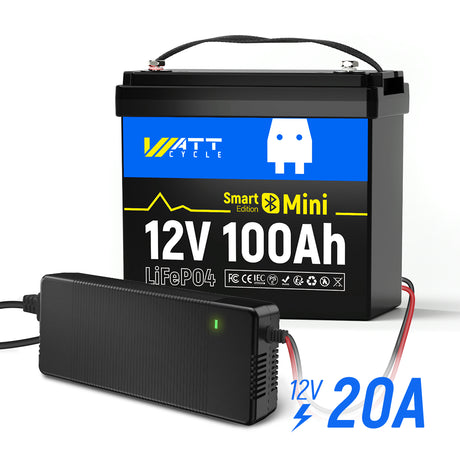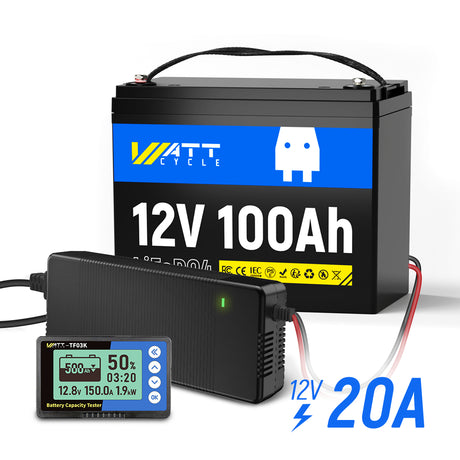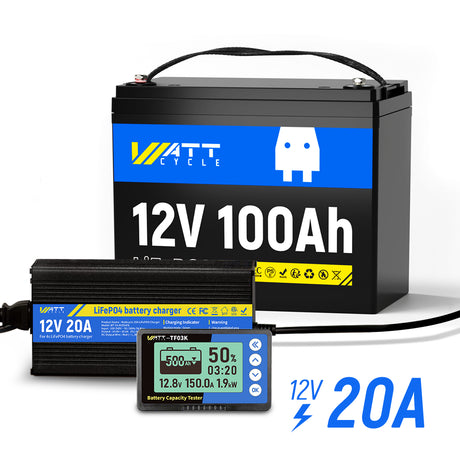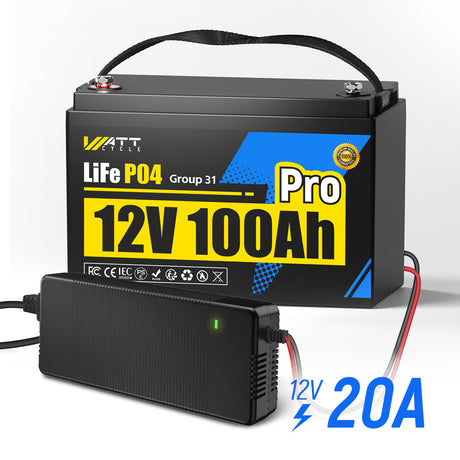AGM vs Lithium: Your Car Audio System Deserve Better
-

Long-Term Durability
Premium LiFePO4 chemistry ensures our LiFePO4 lithium battery car audio outlasts lead‑acid and AGM battery alternatives, offering years of reliable use with minimal upkeep.
-

Stable Power Under Load
WattCycle LiFePO4 car audio battery delivers consistent voltage even during peak bass hits, preventing dimming and audio dropout.
-

Safety Management
Advanced BMS in our lithium car audio battery protects against overcurrent, over‑discharge, and thermal events for dependable operation.
-

Fast Recharge
Designed for rapid recharge, this car audio lithium battery recovers quickly so your system is always ready for the next performance.
Customize Your Capacity Needs
Choose the best lithium batteries for your car audio and speakers.
- Up to 35% off
- Up to 31% off
- Up to 35% off
- Up to 10% off
- Up to 39% off
【🔥Best Seller】12V 100Ah LiFePO4 Battery (Group 24 / Group 31)
In stock (483 units)From $18999$29999Unit price /Unavailable - Up to 42% off
【📳Upgrade to Smart Version】12V 100Ah Mini LiFePO4 Battery
In stock (170 units)From $17999$29999Unit price /Unavailable - Up to 39% off
【⚡Upgraded 110A BMS】12V 100Ah Pro Group 31 LiFePO4 Battery
In stock (310 units)From $18999$29999Unit price /Unavailable - Up to 35% off
【👍WattCycle Recommend】12V 100Ah Mini LiFePO4 Battery with Bluetooth
In stock (154 units)From $21999$32999Unit price /Unavailable - Up to 19% off
12V 100Ah Group 24 LiFePO4 Battery Kit
In stock (23 units)From $24999$30999Unit price /Unavailable - 27% off
- 18% off
- 23% off
- Up to 22% off
12V 50Ah Group U1 LiFePO4 Battery Kit
Low stock (20 units)From $17999$22999Unit price /Unavailable - Up to 22% off
12V 100Ah Mini LiFePO4 Battery with Bluetooth Kit
In stock (33 units)From $27999$35999Unit price /Unavailable - Up to 14% off
12V 100Ah Group 24 LiFePO4 Battery Kit with 500A Monitor
Low stock (20 units)From $31999$36999Unit price /Unavailable - Up to 24% off
12V 100Ah Pro Group 31 LiFePO4 Battery Kit
In stock (35 units)From $24999$32999Unit price /Unavailable
What is the Best Battery for Car Audio Systems?
you need a specialized audio battery replace your old capacitor— and, more often than not, a lithium car audio battery one.
The Need for a Dedicated Battery
A standard starter battery is built to crank your engine and then relies on the alternator to keep it topped up. In contrast, a true car audio system battery is engineered for sustained, high‑current delivery—ideal when your amps and subwoofers demand power well after the engine’s off. Many enthusiasts install a second battery for car audio to isolate their sound system from the starter battery, ensuring neither dim headlights nor a no‑start scenario interrupts the party.
Using a starter battery alone often leads to:
- Voltage Sag: Heavy bass hits pull voltage down, causing uneven sound or clipping.
- Dimming Lights: Your headlights and dash lamps may dim when the audio draw spikes.
- Amplifier Shutdown: Insufficient current can force amps into protection, cutting music mid‑track.
- Battery Damage: Reduced battery lifespan due to deep discharge
Switching to a deep cycle battery for car audio eliminates these headaches by delivering steady voltage under load and rebounding quickly between discharges.
How to Choose the Right Car Audio Battery
Planning for a complete car audio project can be overwhelming when you start trying to calculate all of the factors that impact the acoustics of your car, the power your desire, and the components you plan on using. Use this Car Audio Calculators to plan your total power to facilitate your selection of the appropriate battery capacity.
Then you should consider your desired run time, decide how long you want to play with the engine off - 30 minutes, 2 hours, or more.
Finally, choose the right battery capacity to enhance your car audio system. Don’t forget to factor in your alternator output and whether you’ll use a secondary battery.
Energy (Wh)= Total Power (W) × Run Time (h) × 1.2 (safety margin)
Example: 1000 W Total Power × 2 h × 1.2 = 2.4 KWh.
At WattCycle, a 12V 100Ah lithium car audio battery can provide 1280Wh energy. Take this as a reference and Choose a lithium car audio battery with a rated capacity slightly above your calculated Ah.
Car Audio Battery Calculator
Two Ways to Expand Your Car Audio System Capacity
Whether you're looking to run your setup longer with the engine off or avoid voltage drops during heavy bass hits, there are two practical ways to expand your power reserve.
1. Upgrade to a Dual Purpose Battery
One simple way to boost performance is to replace your starter battery with a dual purpose battery. These are designed to crank your engine and support your car audio system battery needs by delivering steady, high-output power. Built for deep cycling and reliable voltage delivery, they help prevent dimming lights, distortion, and amp cutoffs — perfect for daily drivers with enhanced audio demands.
2. Add a Second Battery for Car Audio
If your system pulls significant power — especially when the engine is off — adding a second battery for car audio is a smart move. This setup separates your sound system’s power source from your vehicle’s primary electronics, reducing the risk of draining your starter battery. However, it’s essential to remember: if your existing battery can’t hold a charge, adding another one won’t solve the root issue.
That said, in cases where your gear keeps running when the engine’s off and you find yourself with a dead starter, installing a high-capacity battery or a matched auxiliary setup may solve the problem. A deep cycle battery for car audio is particularly effective here, offering both endurance and consistent power under load.
| Feature | Dual Purpose Battery | Second Battery for Car Audio |
| Definition | A single unit that both starts the engine and powers audio loads | A dedicated auxiliary battery wired alongside the starter battery |
| Deep‑Cycle Capability | Engineered for moderate deep cycling, balancing cranking & load | Optimized for true deep‑cycle performance under sustained audio draw |
| Voltage Stability | Better than a starter alone, but limited by one battery’s capacity | Superior—isolates audio draw, keeping voltage rock‑steady |
| Installation Complexity | Simple swap-in; fits existing battery tray | Requires isolator, cabling, mounting space and a bit of wiring skill |
| Cost | Lower upfront investment | Cost for additional accessories (battery + isolator kit + installation) |
| Scalability | Capacity fixed to that single battery | Easily expand by adding more batteries or higher‑Ah units |
| System Isolation | Audio and starting share same unit | Fully separates audio load from starter system, protecting both |
| Ideal Use Case | Moderate upgrades or simpler installs | High‑power systems, long off‑engine run times, serious audio rigs |
How to Hook Up a Second Battery for Car Audio
High-performance car audio systems tend to require a whole lot of power, and the original electrical system in some cars just isn't up to the task. The solution in some cases is to install a high output alternator, but that only actually works when the engine is running. If you want more power when the engine is off, then the best option is to install a second battery. Here's your installation guide for add a second battery:
- Match Your Batteries: Use two identical deep‑cycle packs—same brand, group, and production date—to prevent uneven wear
- Parallel Wiring: Connect positive to positive and negative to negative, then ground both negatives to the chassis.
- Heavy‑Gauge Cables & Fusing: Run short, thick cables; install in‑line fuses within 6 inches of each battery’s positive terminal.
- Placement & Protection: Secure batteries in ventilated boxes (trunk, under seat) and mount close to your amplifier; wire the amp directly to the auxiliary battery.
- Charge Management: Add a battery isolator or DC‑DC charger to prioritize engine starts and optimize charging for your second battery for car audio.
Hybrid Power Solution
You can also keep your existing battery and add a deep cycle or marine battery. This option is a little different because you have to wire it so that you can isolate each battery from the electrical system and, more importantly, from each other. Unlike parallel systems, this hybrid approach requires:
- Separate circuits: Wire batteries with a voltage-sensitive relay (VSR) or automatic isolator to prevent cross-drain
- Dual roles: Your OEM battery handles engine starts and vehicle electronics while driving; the deep-cycle battery feeds your audio system when parked
- Fail-safe advantage: Never strand yourself with a dead starter—the isolator ensures your primary battery stays charged for ignition
Battery Placement Matters
Even slim-profile batteries can cause issues. Before final mounting:
- Confirm vertical clearance (minimum ½” between battery terminals and hood)
- Use non-conductive marine battery trays to prevent short circuits
- Avoid heat zones (near exhaust manifolds or turbo systems)
For the complete installation guide and car audio battery wiring diagram (including isolator setup and trunk installation configuration) plus tools lists and load calculation tools, visit our detailed installation blog.
Tailored Solutions for Car Audio Enthusiasts
Battery Management System (BMS)
WattCycle’s car audio battery lineup tackles common obstacles—voltage sag, audio clipping, and premature wear—by delivering unwavering voltage under high‑current demand. Our WattCycle LiFePO4 car audio batteries include an integrated Battery Management System that constantly monitors individual cell voltages and temperatures. If it detects overcharging, over‑discharge, short‑circuit risk, or overheating, the BMS immediately isolates the affected circuit, preventing damage and extending overall pack life. By actively balancing each cell, it ensures uniform performance across the entire battery, warding off premature capacity loss.
When you depend on a lithium car audio battery, consistent output is non‑negotiable. WattCycle’s BMS not only shields against faults but also maintains stable voltage delivery under heavy loads—so your amps never clip and your system never falters. This advanced protection translates to unwavering reliability, letting you focus on the music instead of power concerns.
Application Scenarios
Whether you’re running a backup subwoofer in the trunk or powering a head‑unit‑only upgrade, our solutions adapt to your rig. From a second battery for car audio wired via an isolator to an extra battery for car audio system paired with a high‑output alternator, WattCycle batteries fit seamlessly into any layout.
- Compact Dual‑Purpose Setup: Swap in a dual‑purpose LiFePO4 battery in the engine bay for combined start and audio power.
- Auxiliary Power Module: Mount a deep‑cycle battery alongside your amplifier rack, isolating audio draw from your starter pack.
- Modular Expansion Kit: Start with a 100 Ah module and add additional 100 Ah packs as your system grows—ideal for festival tailgates along Route 66.
- High‑Output Hybrid System: Pair a 280 Ah deep cycle unit with a dual‑purpose battery to support extreme multi‑amp configs.
Each configuration is backed by WattCycle’s expert guidance and hassle‑free support—so you can focus on the music.
Frequently Asked Questions
Q1: Can I replace my starter battery with a lithium car audio battery?
Q1: Can I replace my starter battery with a lithium car audio battery?
Yes—you can swap your OEM starter battery for a lithium car audio battery, provided it meets or exceeds your vehicle’s Cold‑Cranking Amp (CCA) requirements. Some LiFePO4 models are dual‑purpose (starting + deep‑cycle), while others are audio‑only and won’t crank the engine. Always verify the CCA rating before replacing.
Q2: How long does a lithium battery last in car audio?
Q2: How long does a lithium battery last in car audio?
WattCycle LiFePO4 batteries endure up to 5,000–15,000 cycles at 60% depth‑of‑discharge, translating to roughly 8–10 years of regular use—far outlasting typical lead‑acid options.
Q3: What happens if my lithium battery dies while playing?
Q3: What happens if my lithium battery dies while playing?
If voltage falls below the amp’s cutoff threshold, your amplifier will shut down to protect both amp and cells. You can prevent this by monitoring voltage in real time or by installing a second battery for car audio to share the load.
Q4: Can I install a lithium battery myself?
Q4: Can I install a lithium battery myself?
Yes, if you’re comfortable with automotive wiring:
Use 1/0 AWG cables for battery‑to‑battery runs.
Fuse both positive leads within 6 inches of each terminal.
Ground each negative to a clean chassis point.
Verify polarity and cable integrity before testing.
Q5: Do lithium car audio batteries require special alternators?
Q5: Do lithium car audio batteries require special alternators?
No. Most modern 12 V alternators, when regulated between 14.2–14.6 V, charge LiFePO4 packs safely. Just confirm your alternator’s output sits within the recommended window—no aftermarket alternator is usually needed.
Q6: Can a car audio capacitor drain the battery?
Q6: Can a car audio capacitor drain the battery?
No. A quality car audio capacitor stores energy for amplifier peaks and only draws current to recharge after a big bass hit. Its self‑discharge is negligible, so it won’t meaningfully drain your car audio battery.
Q7: Can you use a regular car battery for car audio?
Q7: Can you use a regular car battery for car audio?
You can for light upgrades, but starter batteries aren’t built for repeated deep discharge. Under heavy or extended use, they suffer voltage sag and shortened lifespan. For reliable performance, choose a dedicated deep cycle battery for car audio, or contact us, WattCycle will offer you the most professional advice.

































































































